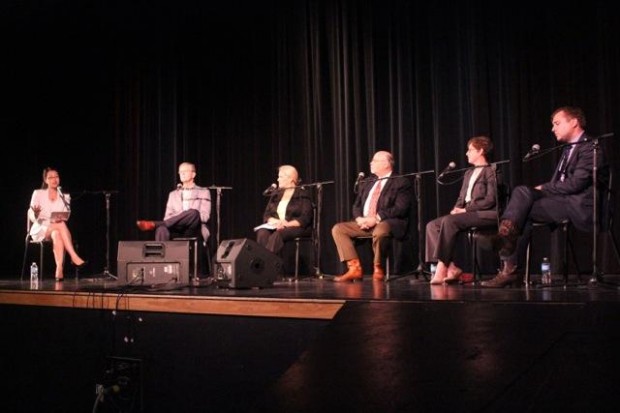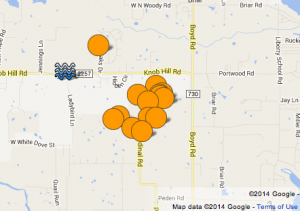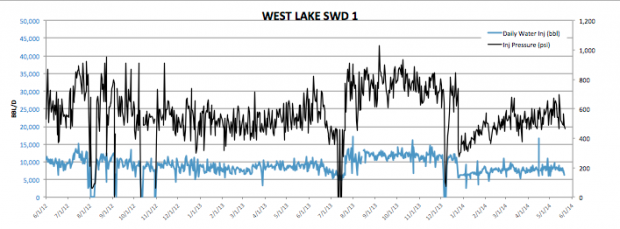Finding Definitive Answers to North Texas Quakes Could Take Years, But Clues Appear

Andy Taylor/KERA
A panel of experts gathered in Azle Wednesday night to talk about what's behind the North Texas earthquake swarm.
What is behind the tremors in North Texas? Starting late last fall, a swarm of quakes struck the communities of Reno and Azle outside of Fort Worth. It’s hardly the first community in the Lone Star State to have to deal with damaged foundations, cracked windows and rude awakenings from quakes: there have been nine other scientifically-researched quake swarms in Texas, all of them in areas of oil and gas drilling activity.
In all of those other Texas cases, injection for either oil and gas drilling wastewater disposal or to enhance oil and gas production has been behind many of the quakes. That mirrors similar phenomena in Oklahoma, Ohio and other states, where wastewater disposal has become the main culprit behind a rise in quakes in what used to be seismically-quiet parts of the country. Oklahoma, for instance, now has more quakes than California, with several smaller quakes taking place yesterday, the same day we held a forum with Dallas’ KERA News, ‘What’s Behind the North Texas Quakes?’
The community forum, featuring a panel of officials and experts, explored what we currently know about the quakes, what can be done about them, and whether or not state regulators and legislators are up to the task of taking actions to prevent more quakes in the future. Here’s what we learned, and some of the questions that remain unanswered:
What Does the Evidence So Far Say About the North Texas Quakes?
Heather DeShon, a seismologist at Southern Methodist University, is leading the scientific research into the Reno and Azle quakes. They’ve deployed a dozen monitors in the area to get a better idea of where and when the tremors occur, and so far they’ve been able to get a good idea of the fault structure in the area, DeShon said. This was a fault that up until this point had been inactive. There are two disposal wells nearby that the team is looking at as they study the quakes. “We’re now working on trying to understand if there is a link between oil and gas industry activities and these earthquakes,” DeShon said.

Map by Andrew Weber/KUT
A map of earthquakes in Reno (orange dots) near the XTO disposal well (blue horizontal waves).
And new information from one drilling company in the area adds to the picture. The day before the forum in Azle, the Railroad Commission of Texas, which regulates drilling and disposal wells in the state, released data from several disposal wells near the epicenters of the quakes (indicated at right by the orange dots). One of those wells (indicated at right with the wavy horizontal lines), owned and operated by XTO Energy, a subsidiary of ExxonMobil, is closest to the centers of the quakes, and is one of two disposal wells being considered by DeShon’s team at SMU.
If you look at the data XTO provided to the Railroad Commission, you’ll find something interesting. Late last summer and well into the fall, the amount of wastewater being disposed of at the well went up significantly, by forty percent. The pressure at which that wastewater was being injected also went up by 35 percent. (These amounts, even at the higher levels, appear to be in line with their permit.) You can see the jump in this graph from XTO:

XTO/Railroad Commission of Texas
This graph from XTO energy shows the amount of wastewater injected and at what pressure at its disposal well in Reno, Texas.
Then, shortly before the New Year, the amount and pressure of wastewater injection dropped significantly, and hasn’t risen to its previous higher levels since. That corresponds with a drop in the number of quakes that have been felt in the region, with the last significant quake occurring in January. There have, however, been hundreds of much smaller tremors that cannot be felt since then.
“Common sense tells me that if you take millions of gallons of water, and you pump it down into a fault bed, you can’t expect anything else [other than earthquakes]. It’s going to shuffle and move things around, that fluid has to go somewhere,” Reno Mayor Lynda Stokes said at the panel. Stokes said area residents could follow the uptick in quakes with the number of trucks coming into the XTO well in Reno to dispose of wastewater. When the truck traffic died down in December and January, so did the quakes.
But perhaps it’s not that simple. If you go even further back to examine the data for XTO’s well, back to 2009 and 2010, you’ll see even higher amounts of wastewater were disposed of at the well during those years, according to the records XTO submitted for the well. But there were not earthquakes in the area at that time.
This is where DeShon and her team at SMU studying the quakes come in. By placing additional monitors in the area and piecing together all of these clues, they can then organize it all into a study that could help inform the next steps. But the study must be peer-reviewed, and getting all of the data needed will take time, DeShon cautioned Wednesday. It could take between six and 18 months before a final study is released.
So far, DeShon’s team has found that the quakes are occurring at a depth from two to nearly eight kilometers. The disposal wells in the area are injecting wastewater into the same formation, at a range of two to three kilometers deep. So the earthquakes are occurring both at the same depth as this disposal wells, but they also go deeper.
If Disposal Wells Are the Culprit in North Texas, What Can Be Done?
Let’s say the results of SMU’s study show that disposal wells have been causing quakes. What should be done then? While many residents or Reno and Azle have called for a halt to disposal well activity, including Mayor Stokes, state Rep. Phil King (R-Weatherford), said at the forum that there are some 3,600 disposal wells in Texas, and most of them aren’t linked to quakes. Adopting a blanket suspension would be counter-productive, he said. “If it’s caused by man, then what do we have to do fix that?” King asked. “It may be something simple, it may be something large. I don’t know. It may be that in some areas, you can’t do a disposal well,” King said. Or wells in areas with faults could have their pressures and amounts of wastewater reduced.
A legislative subcommittee has been put together to look into the quakes, and held their first hearing last month. No new regulations were proposed at that hearing, however, and a similar theme emerged: more time is needed to draw a link between disposal activity and man-made quakes, despite the body of scientific evidence going back to the sixties.
In several instances, disposal well operators have voluntarily either reduced or suspended disposal at their sites after they have been linked to quakes, which appears to be the case with the XTO disposal well in Reno.
Is Texas Up to the Task of Taking Action?
This is perhaps the greatest unknown when it comes to the issue of Texas man-made quakes.
For years, the Railroad Commission of Texas questioned the peer-reviewed science linking wastewater disposal or injection to earthquakes. In private correspondence obtained through open records requests, however, staff at the commission appeared to acknowledge the scientific studies linking drilling activity to quakes.
Many residents at Wednesday’s forum said they didn’t trust the commission to deal with the issue. The three elected commissioners receive large donations from the energy industry and are widely-viewed as serving their interests first.
“In Texas, oil and gas pays the freight, and you’ve got to understand that,” Azle resident John Hamilton told KERA News after the forum. “That’s the way it’s been, and the way it always will be.”
Amid the uproar over the quakes in Reno and Azle this past winter, resulting in dozens of residents mobilized to take their concerns directly to the Railroad Commission in Austin, a few initial steps have been made. The commission hired a seismologist, Craig Pearson, who has attended a workshop with other states on what can be done about man-made quakes.
In Oklahoma, where the man-made quakes have been stronger, more frequent, and more damaging, state officials have in some cases suspended disposal wells. They’ve also required more timely data from disposal well operators on the amount and pressure of wastewater that they’re injecting each day.
“Things don’t happen always the way we want them to, immediately,” Bill Stevens with the Texas Alliance of Energy Producers, said at the forum. “And I sense the frustration. It’s gonna be a year, maybe two years, before we have the answers.”
We have audio of the whole event here for you to listen to:
Audience members were also invited to ask questions of the panel. Here’s that portion of the forum:
Support for StateImpact Texas’ ‘Road Show’ was provided in part by the Energy Institute at the University of Texas at Austin.


